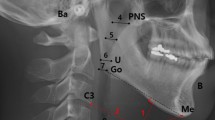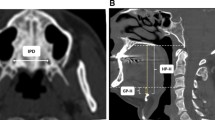Abstract
Introduction
In Indian population, the estimated prevalence of OSA is 7.5% to 13.5%. Craniofacial anatomical variations and obesity are the major risk factors for OSA. Among the craniofacial anatomy, the neck circumference and abnormal craniofacial morphology play an important role in the pathogenesis of OSA. Obesity is the major risk factor for which waist and hip circumference and BMI are considered.
Aim
The aim of this paper was to evaluate the impact of hyoid position, mandible body length (MBL) and anthropometric measurements on sleep indices in patients with snoring in North Indian population.
Methods
In this cross-sectional study, we analyzed the position of the hyoid, mandible body length and anthropometric measurements, of 104 patients attending ENT OPD with the complaint of snoring and excessive daytime sleepiness. All subjects underwent a full overnight polysomnography. The position of the hyoid, MBL and the anthropometric measurements were compared with the sleep architecture of the subjects, and a p value < 0.05 was considered significant.
Results
A strong positive correlation is seen between the position of the hyoid, MBL and anthropometric measurements on the sleep indices in this study. Pearson 2-tailed correlation was evaluated, and upon analysis, it was found that at significance level of 0.01, obesity (BMI) is strongly correlated with overall AHI with correlation coefficient of 0.926, whereas AHI in supine position was having coefficient of 0.837 and AHI on right side and left side was almost same 0.597 and 0.575, respectively. Similarly WC is strongly correlated with AHI and RDI, having coefficient of 0.930 with both. NC and HC also showed strong positive correlation with overall AHI and RDI having correlation coefficient of 0.893, 0.926 with AHI and 0.893, 0.926 with RDI, respectively. The MBL also showed a strong positive correlation with AHI and RDI with correlation coefficient of 0.994 in both. The position of the hyoid also showed a strong positive correlation with AHI and RDI.
Conclusion
Results indicated that significant positive correlation was found between position of the hyoid, MBL and anthropometric measurements on the sleep indices in patients with snoring in North Indian population.


Similar content being viewed by others
References
Rotenberg BW, Vicini C, Pang EB, Pang KP (2016) Reconsidering first-line treatment for obstructive sleep apnea: a systematic review of the literature. J Otolaryngol Head Neck Surg 23:45
Sleep-related breathing disorders in adults: recommendations for syndrome definition and measurement techniques in clinical research. The Report of an American Academy of Sleep Medicine Task Force. Sleep; 1999; 22(5):667–689
Araújo CLO, Ceolim MF (2010) Sleep quality of elders living in long- term care institutions. Rev Esc Enferm USP. 44(3):619–626
Onat A, Hergenc G, Yüksel H, Can G, Ayhan E et al (2009) Neck circumference as a measure of central obesity: associations with metabolic syndrome and obstructive sleep apnea syndrome beyond waist circumference. Clin Nutr 28:46–51
Cizza G, de Jonge L, Piaggi P, Mattingly M, Zhao X et al (2014) Neck circumference is a predictor of metabolic syndrome and obstructive sleep apnea in short-sleeping obese men and women. Metab Syndr Relat Disord 12:231–241
Hoffstein V, Mateika S (1992) Differences in abdominal and neck circumferences in patients with and without obstructive sleep apnoea. Eur Respir J 5:377–381
Susarla SM, Thomas RJ, Abramson ZR, Kaban LB (2010) Biomechanics of the upper airway: changing concepts in the pathogenesis of obstructive sleep apnea. Int J Oral Maxillofac Surg 39(12):1149–1159
Zucconi M, Ferini-Strambi L, Palazzi S, Orena C, Zonta S, Smirne S (1992) Habitual snoring with and without obstructive sleep apnea: the importance of cephalometric variables. Thorax 47:157–161
Duran J, Esnaola S, Rubio R, Iztueta A (2001) Obstructive sleep apnea-hypopnea and related clinical features in a population-based sample of subjects aged 30 to 70 yr. Am J Respir Crit Care Med 157:685–689
Burstone CJ, James RB, Legan H, Murphy GA, Norton LA (1978) Cephalometrics for orthognathic surgery. J Oral Surg 36:269–277
Rechtschaffen A, Kales A (1968) A manual of standardized terminology, techniques and scoring system for sleep stages in human subjects. Brain Information Service/Brain Research Institute, University of California, Los Angeles
Iber C, Ancoli-Israel S, Chesson A, Quan SF (2007) American Academy of Sleep Medicine (2007) The AASM manual for the scoring of sleep and associated events: rules, terminology and technical specifications, 1st edn. AASM, Westchester
McNicholas WT (2008) Diagnosis of obstructive sleep apnea in adults. Proc Am Thorac Soc 5:154–160
Johns MW (1991) A new method for measuring daytime sleepiness: the Epworth sleepiness scale. Sleep 14:540–545
Redline S, Tishler PV (2000) The genetics of sleep apnea. Sleep Med Rev 4:583–602
Bharadwaj R, Ravikumar A, Krishnaswamy NR (2011) Evaluation of craniofacial morphology in patients with obstructive sleep apnea using lateral cephalometry and dynamic MRI. Indian J Dent Res 22:739–748
Olszewska E, Sieskiewicz A, Rozycki J, Rogalewski M, Tarasow E, Rogowski M et al (2009) A comparison of cephalometric analysis using radiographs and craniofacial computed tomography in patients with obstructive sleep apnea syndrome: preliminary report. Eur Arch Otorhinolaryngol 266:535–542
Julià-Serdà G, Pérez-Peñate G, Saavedra-Santana P, Ponce-González M, Valencia-Gallardo JM, Rodríguez- Delgado R et al (2006) Usefulness of cephalometry in sparing polysomnography of patients with suspected obstructive sleep apnea. Sleep Breath 10:181–187
Young T, Palta M, Dempsey J et al (1993) The occurrence of sleep disordered breathing among middle-aged adults. N Engl J Med 328:1230–1235
Strohl KP, Redline S (1996) Recognition of obstructive sleep apnea. Am J Respir Crit Care Med 154:279–289
Grunstein R, Wilcox I, Yang TS et al (1993) Snoring and sleep apnoea in men: association with central obesity and hypertension. Int J Obes Relat Metab Disord 17:533–540
Kales A, Cadieux RJ, Bixler EO et al (1985) Severe obstructive sleep apnea. I: Onset, clinical course, and characteristics. J Chron Dis 38:419–425
Davies RJ, Stradling JR (1990) The relationship between neck circumference, radiographic pharyngeal anatomy, and the obstructive sleep apnoea syndrome. Eur Respir J 3:509–514
Stradling J, Crosby J (1991) Predictors and prevalence of obstructive sleep apnoea and snoring in 1001 middle aged men. Thorax 46:85
Katz I, Stradling J, Slutsky AS et al (1990) Do patients with obstructive sleep apnea have thick necks? Am Rev Respir Dis 141:1228–1231
Kushida CA, Efron B, Guilleminault C (1997) A predictive morphometric model for the obstructive sleep apnea syndrome. Ann Intern Med 127:581–587
Deegan PC, McNicholas WT (1996) Predictive value of clinical features for the obstructive sleep apnoea syndrome. Eur Respir J 9:117–124
Yamagishi K, Ohira T, Nakano H, Bielinski SJ, Sakurai S et al (2010) Cross-cultural comparison of the sleep-disordered breathing prevalence among Americans and Japanese. Eur Respir J 36:379–384
Davidson TM, Patel MR (2008) Waist circumference and sleep disordered breathing. Laryngoscope 118:339–347
Soylu AC, Levent E, Sarıman N, Yurtlu S, Alparslan S et al (2012) Obstructive sleep apnea syndrome and anthropometric obesity indexes. Sleep Breath 16:1151–1158
No authors listed. Executive Summary of The Third Report of The National Cholesterol Education Program (NCEP) Expert Panel on Detection, Evaluation, and Treatment of High Blood Cholesterol in Adults (Adult Treatment Panel III). JAMA 2001; 2486–2497.
Lee RW, Vasudavan S, Hui DS, Prvan T, Petocz P et al (2010) Differences in craniofacial structures and obesity in Caucasian and Chinese patients with obstructive sleep apnea. Sleep 33:1075–1080
Martins AB, Tufik S, Moura SM (2007) Physiopathology of obstructive sleep apnea-hypopnea syndrome. J Bras Pneumol 44:93–100
Battagel JM, L’Estrange PR (1996) The cephalometric morphology of patients with obstructive sleep apnoea (OSA). Eur J Orthodont 18:557–569
Anderson L (1991) Brattstorm V (1991) Cephalometric analysis of permanently snoring patients with and without obstructive apnoea syndrome. Int J Oral Maxillofac Surg 20:59–162
Lyberg T, Krogstad O, Djupesland G (1989) Cephalometric analysis in patients with obstructive sleep apnoea syndrome. J Laryngol Otol 103:293–297
Pracharktam N, Hans MG, Strohl KP, Redline S (1994) Upright and supine cephalometric evaluation of obstructive sleep apnea syndrome and snoring subjects. Angle Orthod 64:63–72
Author information
Authors and Affiliations
Corresponding author
Ethics declarations
Conflict of interest
None.
Additional information
Publisher's Note
Springer Nature remains neutral with regard to jurisdictional claims in published maps and institutional affiliations.
Rights and permissions
About this article
Cite this article
Kakkar, V., Sarin, V., Dhawan, A. et al. Impact of Hyoid Position, Mandible Body Length and Anthropometric Measurements on Sleep Indices in Patients with Snoring in North Indian Population. J. Maxillofac. Oral Surg. 21, 253–259 (2022). https://doi.org/10.1007/s12663-020-01505-w
Received:
Accepted:
Published:
Issue Date:
DOI: https://doi.org/10.1007/s12663-020-01505-w




